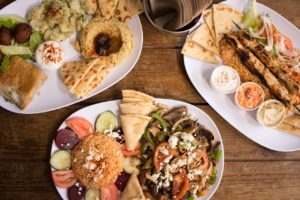Spice Trade Chronicles 9 Arabia
Onward across the Red Sea and the Indian Ocean to the East and Arabia.
I like the title “Arabia”, it sounds mystical, something out of a fairy tale, or a Disney movie! When the spice trade began, the route connected Asia, Northeast Africa and Europe. The stories and history that went along with this journey brought the world together with spices and flavor. Spices brought legends, mystery, war, and prosperity to all that were involved in this ancient adventure.
I will focus on the region now known as the Middle East, which also includes lands around the Mediterranean and Red Seas and the Arabian Sea. This entire area is where human civilization began, or so we think. Over the course of history many important inventions were created here that changed the world including, discovery of the wheel, math, sailboats, maps, writing and the concept of time. 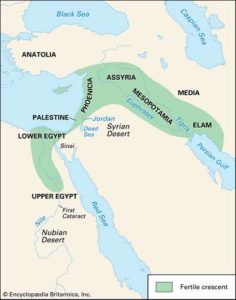 This is where Jesus walked and the two largest religions in the world, Christianity and Islam originated here. There is so much history in this region and the spices have told a tale though out time.
This is where Jesus walked and the two largest religions in the world, Christianity and Islam originated here. There is so much history in this region and the spices have told a tale though out time.
The Fertile Crescent is part of the Middle East, and it is also known as the “Cradle of Civilization.” It’s a small region in the Middle East which curves, like a quarter-moon shape, from the Persian Gulf, through modern-day southern Iraq, Syria, Lebanon, Jordan, Israel and northern Egypt.
These were pretty recent discoveries, as they were written in a language only deciphered in the last century.
Being that this is believed to be where written language began, recipes were found on old cuneiform tablets and the ingredients were pretty unappetizing for our tastes today, but commonly found spices such as cumin, saffron, leeks, garlic and coriander are referenced there. These scribes can now be found on display at Yale University in their Babylonian Collection. One of the two dozen recipes described making a stew of young goat with garlic, onions and sour milk. Other stews were made from pigeon, mutton and spleen.
According to the curators at the Yale Museum in Connecticut, these clay tablets contain the earliest written recipes in history. The oldest known recipe dates back to 2200 B.C. It called for snake skin, beer and dried plums to be mixed and cooked. Another tablet from the same period has the oldest recipe for beer.
I will include recipes in this chapter that are much more appealing! Beef chicken, pork and legumes are popular proteins. Most dishes are served with rice, bulgur wheat and flat breads. Flat breads are usually served with a “mezze” featuring a number of dips and snack foods like olives, cheese and jam. This is served at every meal.
The climate is very diverse and many vegetables are able to be cultivated all over.
Summer vege’s like eggplant and tomato, hearty vege’s we think of as winter vege’s such as turnips, leeks, and cabbage are very common. Easy to grow spinach, lettuces and onions of course are plentiful. Pulses are a common protein because you don’t need refrigeration to store the dried beans. Lentils, fava beans and chick peas are incorporated into many dishes throughout the region. Fruits and olives are grown all over, and dried fruits are common ingredients in both savory and sweet dishes. Drying is another way to preserve the food without refrigeration. Citrus fruits are usually pickled or preserved with salt. Cheese is common because the cow is sacred, feta and halloumi are included in mezze as well as a variety of nuts and seeds, pistachios, pine nuts and sesame to name a few. And of course, we have our spices, cinnamon, cardamom, coriander, fenugreek, cumin, oregano, mint, tarragon, thyme, saffron, dried lime, cassia, dill, turmeric
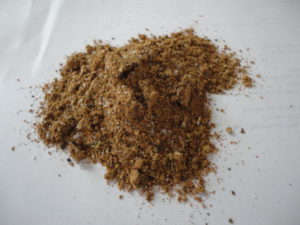
and sumac. Many of these come together to create delicious spices mixes such as baharat, advieh, za’atar and my very favorite, Hawaij.
Before I get into recipes I just wanted to take a minute and talk about the wonderful lentil bean!
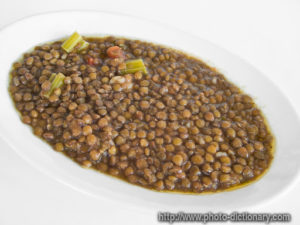 Lentils are a sta
Lentils are a sta
ple in Middle Eastern and Indian diets as well as all over the world. Lentils sustained people back to biblical times, they are referred to in the bible where Esau sold his birthright for a bowl of lentils. They are a super food! Rich in protein, high in soluble fiber, and they’ll keep you going and give you all the protein you need without the fat or cholesterol of animal proteins. They also provide you with iron, magnesium, zinc and B vitamins. They are the 2nd highest bean protein source after soybeans. They are also high in folate, which is an important nutrient for pregnant women. Folate helps to build new cells which can only help the baby grow!
There are so many vegetarian dish recipes that include the lentil. They range from soups, salads, fritters, “meat” sauces and pies. You can even put them in desserts like cookies and brownies! Of course you can’t forget good ol’ rice and beans, serve them with brown rice and they become a complete source of protein. I love lentils, they are my favorite bean to use in veggie burgers and soup.
There is an air of mysticism surrounding Middle Eastern dishes.
 The spice mixtures, use of fruits and flowers and the use of their locally grown fruits and vegetables, give this cuisine a unique background that can only be found in this area of the world. How did the cooks way back when figure out how to combine these spices to get these unbelievable flavors? I don’t think anyone knows the answer to this question. And, of course, we can try to mimic the flavors, but they’ll never be truly the same. All in all, I’ve discovered a few crazy good dishes that I am including on this page.
The spice mixtures, use of fruits and flowers and the use of their locally grown fruits and vegetables, give this cuisine a unique background that can only be found in this area of the world. How did the cooks way back when figure out how to combine these spices to get these unbelievable flavors? I don’t think anyone knows the answer to this question. And, of course, we can try to mimic the flavors, but they’ll never be truly the same. All in all, I’ve discovered a few crazy good dishes that I am including on this page.
Starting with Spice Mixes, these make your life so much easier when you come home from work tired and hungry and just want to throw something together. If you have these mixtures on hand, recipe planning is a cinch! And you can make something exotic, even when you’re tired and don’t feel like spending a lot of time cooking dinner.
Advieh is a Persian spice mix that actually means “spice” in the Persian language. This mixture is used in Iranian cuisine in rice, chicken, and bean dishes. Use Advieh to season a Make It your Own Israeli Couscous. To make this authentic, you really need preserved lemons. Make your own, or buy them at a market specializing in European and Middle Eastern products. They take weeks to cure, so it isn’t something you can do last minute. You can always substitute lemon zest and juice, you just won’t get that exotic flavor.
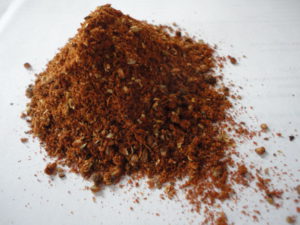
Baharat is another mixture used in Middle Eastern cooking. It adds depth to rice, soups, meat, fish and chicken dishes. You can make your own, or find it here. Use it to make Lahmacun, a spiced meat “pizza” or flatbread. Use the leftover dough, if you have any to make Spiced Middle Eastern Lamb Patties with Pita and Yogurt. This is a common street food found all over the Middle East.
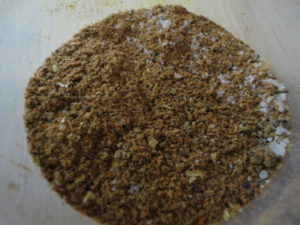
Of course, I have to include Za’atar which is delicious on breads, salads, meats, just about everything. It could be your new salt and pepper!
There are so many recipes, I really don’t know were to begin!
I’m all about easy delicious food, and when you are given the options of all these spices and spice blends, it can make any meal special. Just to share, when I was experimenting with the Advieh spice, which has many variations, it was towards the end of the day, and I was just about cooked out! Most often, recipes include flavorings such as olive oil, tahini, rose water, honey and of course, many different spice blends. Last night, I wanted a quick meal, so I tried it on Chicken Thighs and Beet Noodles. yum!
I’m going to take this idea and run with it, many of the recipes I have been researching are pretty complex and have a lot of ingredients. I have taken some of these ideas and made them my own. In trying these ideas, I hope this gives you ideas to take a recipe and Make It Your Own! Another simple one pan meal is Chicken and Noodles, Persian style.
Getting back to the subject, most meals begin with a Mezze. 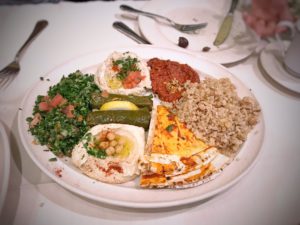 This can be as complex or as simple as you’d like. The chic hotels and restaurants probably give you a spread so big you wouldn’t want anything else. Other places and at home, it would just be bread, pita or flatbread, a pulse of some sort, dried and fresh fruits, cheese and nuts. A typical Mezze spread would probably include hummus, pita, baba ganoush, grilled halloumi cheese and an assortment of fresh fruit, grapes, melons, olives and dried fruit like dates and apricots. Some crunchy nuts would probably round out the meal such as pistachios, almonds and pine nuts.
This can be as complex or as simple as you’d like. The chic hotels and restaurants probably give you a spread so big you wouldn’t want anything else. Other places and at home, it would just be bread, pita or flatbread, a pulse of some sort, dried and fresh fruits, cheese and nuts. A typical Mezze spread would probably include hummus, pita, baba ganoush, grilled halloumi cheese and an assortment of fresh fruit, grapes, melons, olives and dried fruit like dates and apricots. Some crunchy nuts would probably round out the meal such as pistachios, almonds and pine nuts.
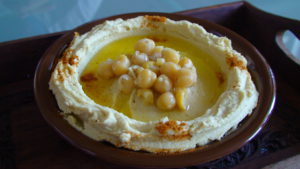 The word hummus actually means chickpeas in Arabic.
The word hummus actually means chickpeas in Arabic.
The earliest recipe found for hummus was found in a cookbook in Cairo in the 13th century. This was after tahini was introduced as a condiment. Tahini is made from sesame seeds, basically sesame seed butter. Hummus encompasses everything common in the Middle Eastern region, chickpeas, lemon, olive oil, and garlic.
Everyone these days know what hummus is, but did you know that hummus is even considered an aphrodisiac? It’s so high in nutrients, iron, magnesium, zinc, and potassium, which are all known to boost physical energy. Maybe that ‘s what you should eat on Valentine’s Day!
These days, everyone is eating hummus. It’s not only great as a dip for pita bread, but you can use it in place of mayo, make a re-creation of it and water it down to use for gravy, bake with it, it’s great over fish.
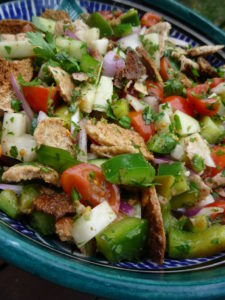
Baba ghanoush is the other dip served with Mezze that is a dish of baked, mashed eggplant with olive oil and spices. These two kind of get stuck together on a platter, and there’s a reason for it. They just are a match made in heaven!
Vegetables abound and grow prolifically. These would include eggplant, onions, tomatoes, artichokes, peppers, and lettuces, just to name a few.
Whole grains such as bulger wheat and barley stand in for rice lots of the time, but rice is eaten at almost every meal. Proteins such as chicken, eggs, beef, and legumes are used in most dishes. Pork is prohibited in the Muslim religion so is its consumption is pretty much null.
Beans, or pulses are so popular, they keep forever, don’t need refrigeration, and are super nutritious.
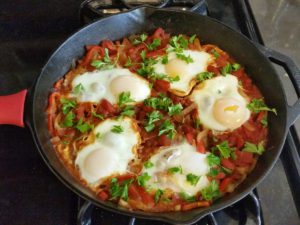
Legumes are eaten at almost every meal. They are the predominant staple of most people throughout the region. Legumes are a healthy protein, and are so nutritious! Ful medames, Mashed fava beans dressed in oil, lemon, and chili served with toppings and bread is eaten for breakfast and provides a nourishing meal to get you through the morning and beyond. It is flavored with olive oil, lemon and chiles. Another popular breakfast dish that I see recipes popping up for everywhere is Shakshuka, basically poached eggs in a spicy tomato sauce.
Of course, Falafel, made from chick peas, is a popular street food as well as a lunch or dinner treat. Lentils and split peas, the most nutritious beans of all are eaten stewed with rice in many variations throughout the region. Lentil soups and white bean soups are popular for lunch or as a first course followed by kebab and meat and rice dishes.
Dolma is a popular dish and simply describes something stuffed. Commonly stufffed vegetables are tomatos, peppers, onions, zucchini, cabbage, eggplant or grape leaves, but it can be anything. The filling is usually ground meat and rice, but only rice and spices is also common.
After Mezze, the main meal is consumed. This can include kebab, stew, kofta, (which I think of as a fancy meatball), rice casseroles, grilled meat or fish and dolma. Kofta, and fritters such as  Falafel are common street foods as well as to make up the main course at a meal. Kofta are meatballs fortified with bulgher wheat as well as ground lamb and spices. Dolma, stuffed vegetables with meat and rice are common for both meals and celebrations. Many forms of rice pilaf are popular and usually contain dried fruit as well as spices and are served either cooked with meat or with the meat on the side.
Falafel are common street foods as well as to make up the main course at a meal. Kofta are meatballs fortified with bulgher wheat as well as ground lamb and spices. Dolma, stuffed vegetables with meat and rice are common for both meals and celebrations. Many forms of rice pilaf are popular and usually contain dried fruit as well as spices and are served either cooked with meat or with the meat on the side.
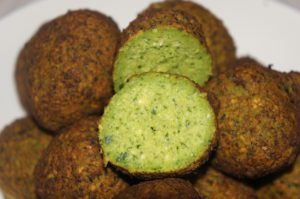 Most meals are accompanied by a rice dish that is made with dried fruit and aromatics and a salad. Salad can also be part of Mezze. Falafel, tasty chickpea fritters, are served either with the Mezze, or in a wrap or over a salad. One of my favorites!Very little is wasted, Fattoush is a salad that uses up garden vegetables and leftover pita bread. Tabbouleh, often eaten with a meal can include all the bits leftover in your fridge of onions, tomatoes and herbs Mixed with bulgher wheat, or couscous, this salad makes a complete vegetarian meal. Both salads are dressed simply with a lemon garlic vinaigrette. Many vegetables are pickled to preserve them too, which are served both with Mezze and at a meal.
Most meals are accompanied by a rice dish that is made with dried fruit and aromatics and a salad. Salad can also be part of Mezze. Falafel, tasty chickpea fritters, are served either with the Mezze, or in a wrap or over a salad. One of my favorites!Very little is wasted, Fattoush is a salad that uses up garden vegetables and leftover pita bread. Tabbouleh, often eaten with a meal can include all the bits leftover in your fridge of onions, tomatoes and herbs Mixed with bulgher wheat, or couscous, this salad makes a complete vegetarian meal. Both salads are dressed simply with a lemon garlic vinaigrette. Many vegetables are pickled to preserve them too, which are served both with Mezze and at a meal.
Breads are usually a flat bread such as pita or crusty loaves. Different types of “pizza” or flatbreads are popular for meals and snacks. Lahmacun, topped with ground meat and spices, and Lavash, a flatbread for wraps are common savory breads. Most sandwiches come in the form of wraps since the bread of choice is pita. Shwarma, a spicy grilled meat sandwich is popular among young and old alike. Yogurt is used in dressings and sauces and is much thicker than we see in America. It is a cross between yogurt and cheese, it is very sour.
Desserts range from puddings to cakes to fancy puff pastry delights.
Desserts include filled pastries such as phyllo dough and vermicelli pastry include custards and fruits, usually smothered with a light sugar syrup. Baklava is a phyllo dough pastry baked with nuts and honey and if very easy to find in coffee shops, markets and most grocery stores. Semolina flour is used in cakes and pastries to make moist, sweet desserts including a sugar syrup made with rose or orange water, such as Basbousa.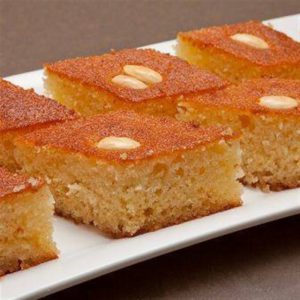
Strong coffee and strong tea are consumed throughout the day.
The blends are brewed and steeped longer than conventional brews, and served with sugar. Cardamom is used as a spice in many teas. Hawaij is a spice blend added to coffee and gives it the most awesome taste and aroma, you have to try it! Beer has been popular for over 6,000 years, but Muslim religion forbids consuming alcohol, so most of the people stick with coffee and tea.
Whether you make a whole bunch of small dishes and throw a Mezze for your friends, or dig right in and make a meal, no matter what you try, you’re sure to feel like you’ve taken a vacation to an exotic place full of fantasy and fun!
Please let me know if you have any variations on these recipes, as I know I’ve only touch the tip of this ice berg! Thank you, Jeanette.

